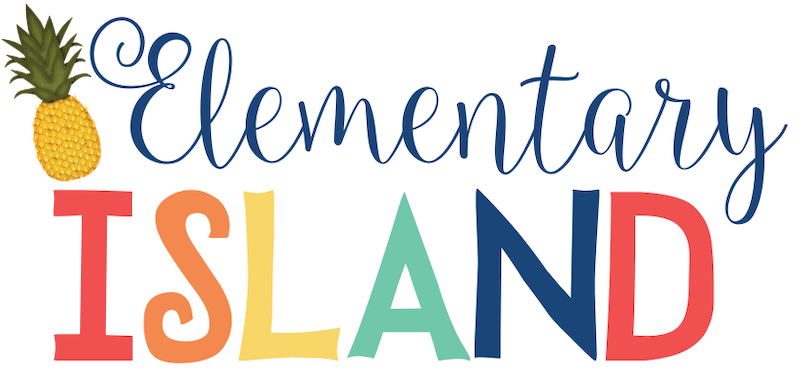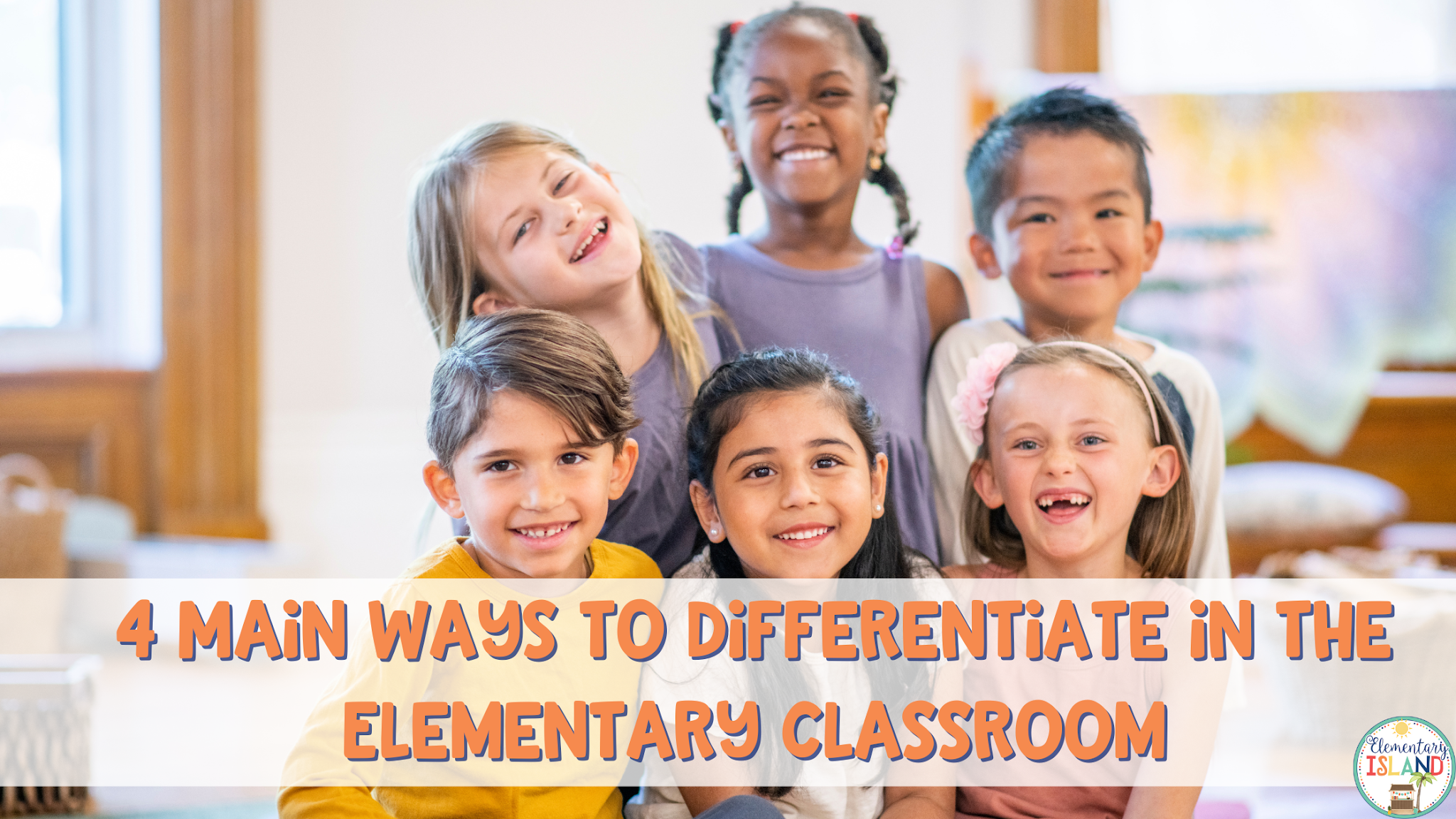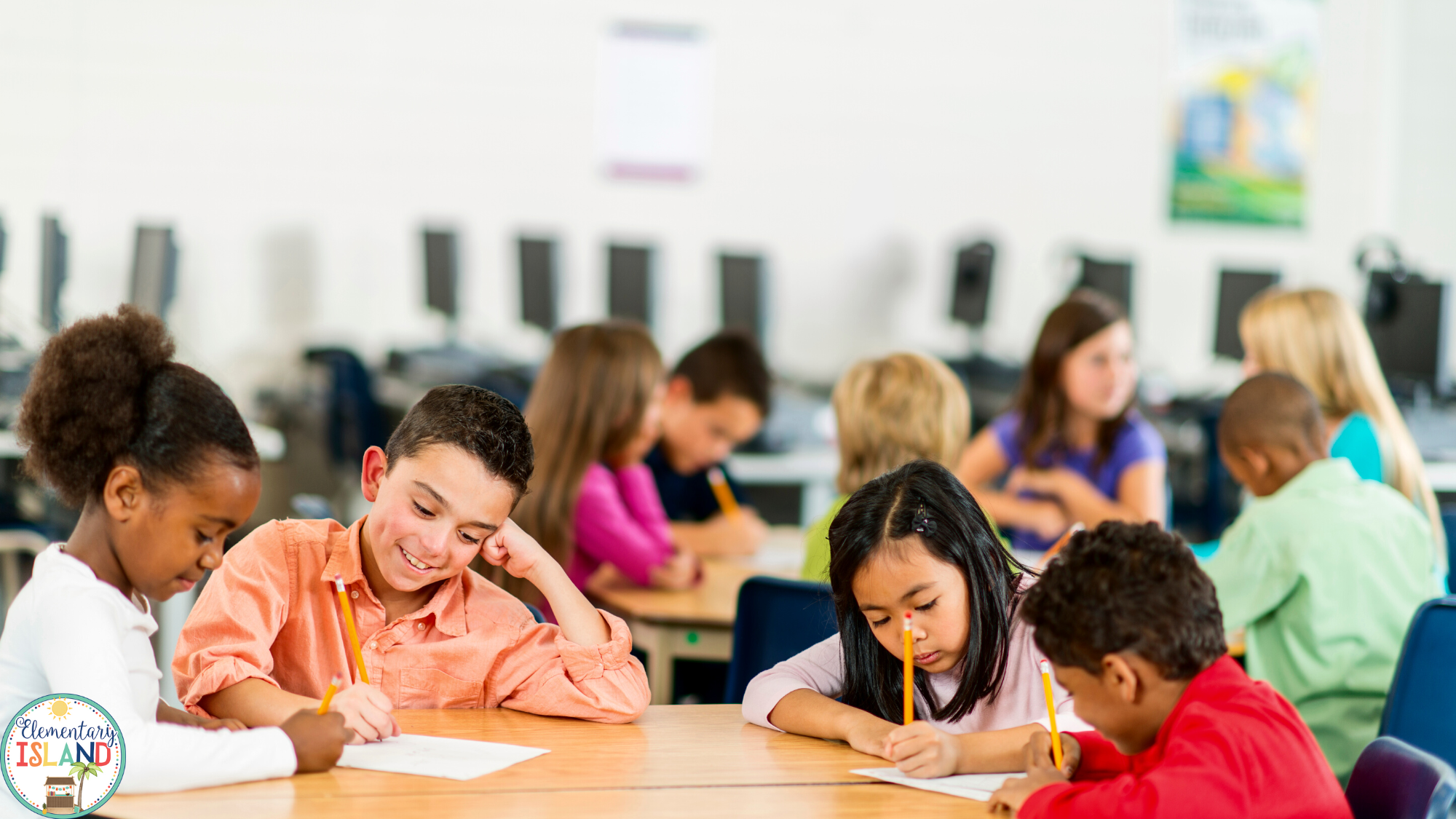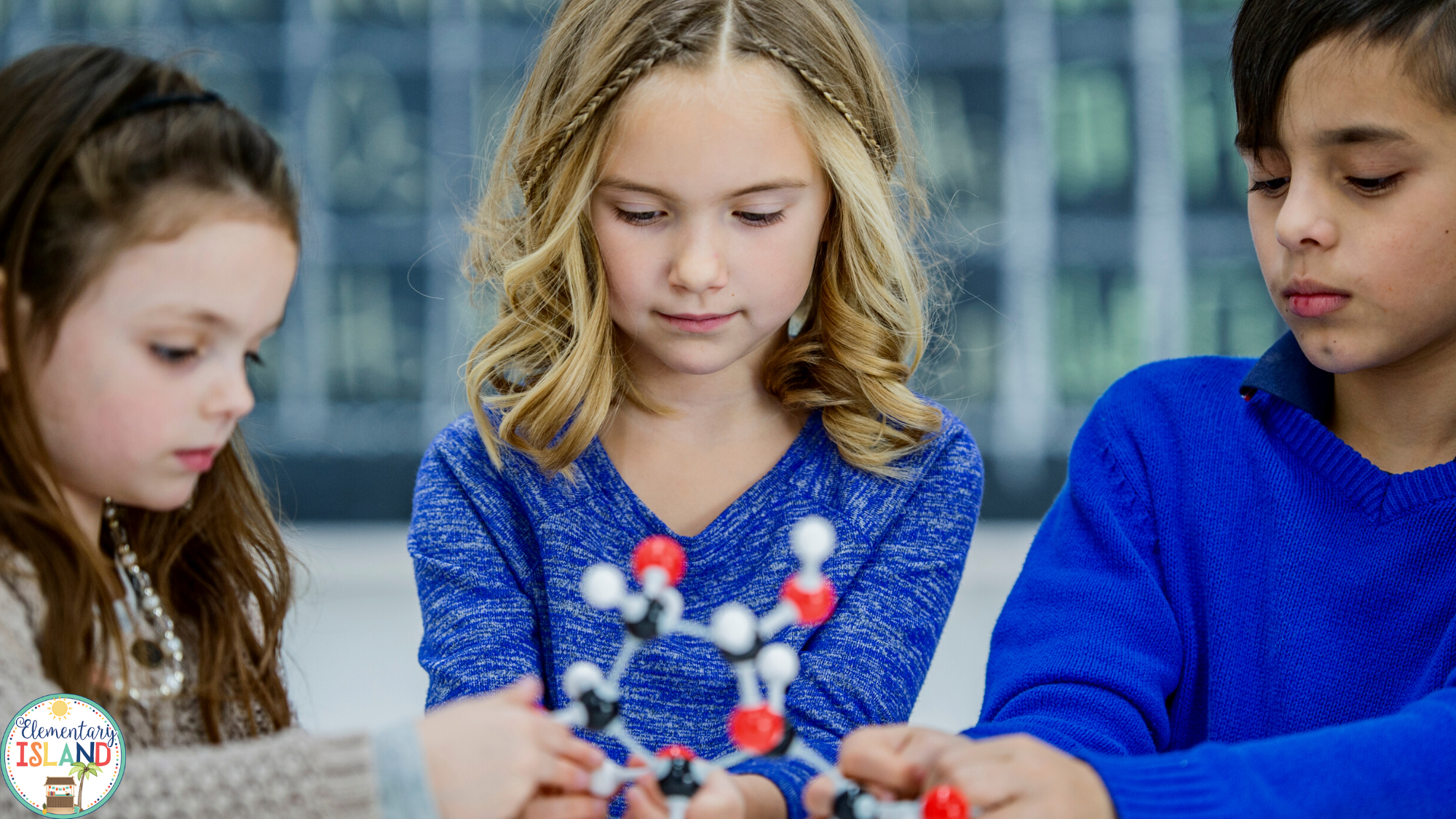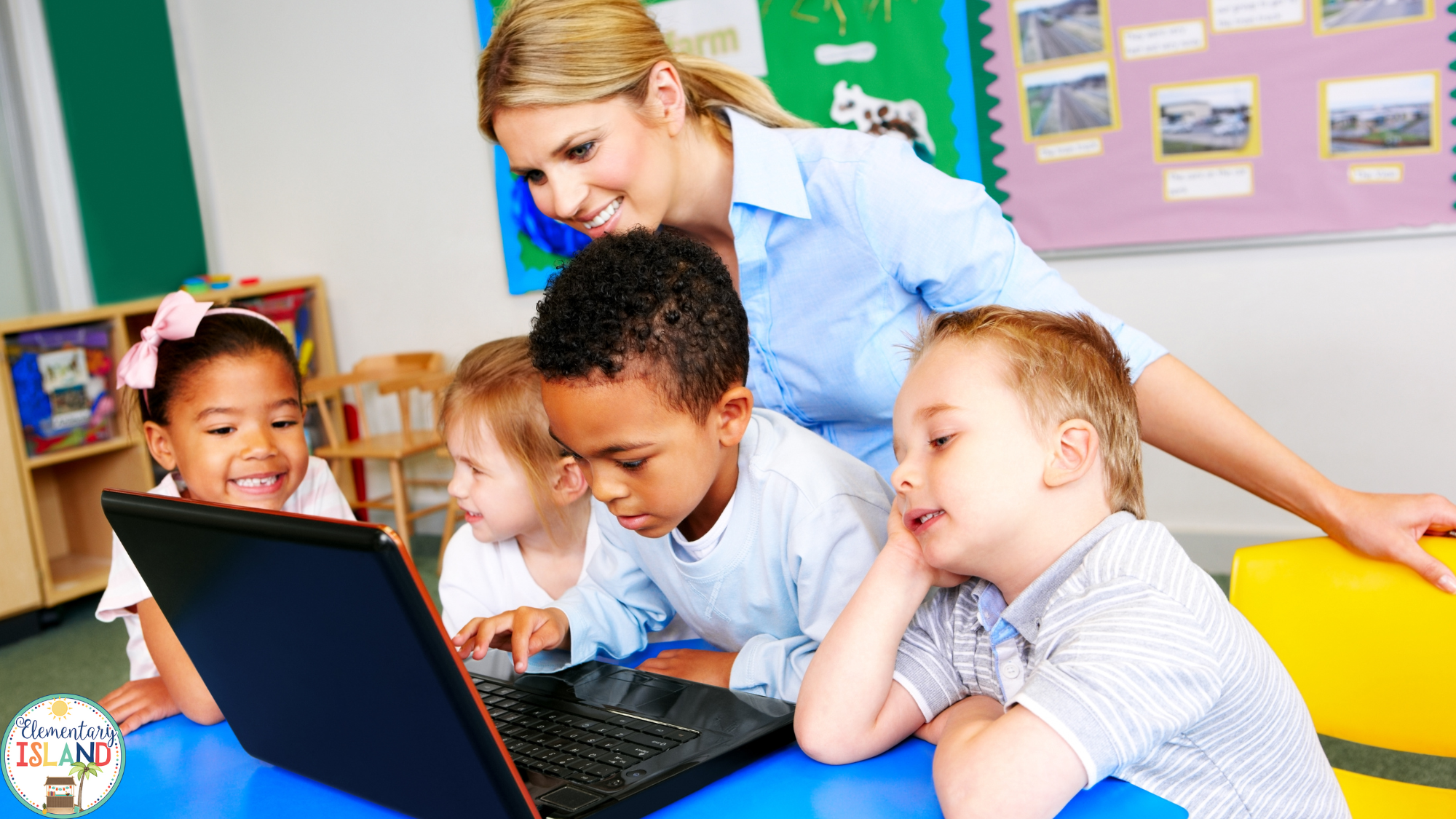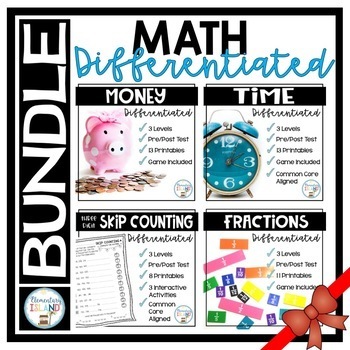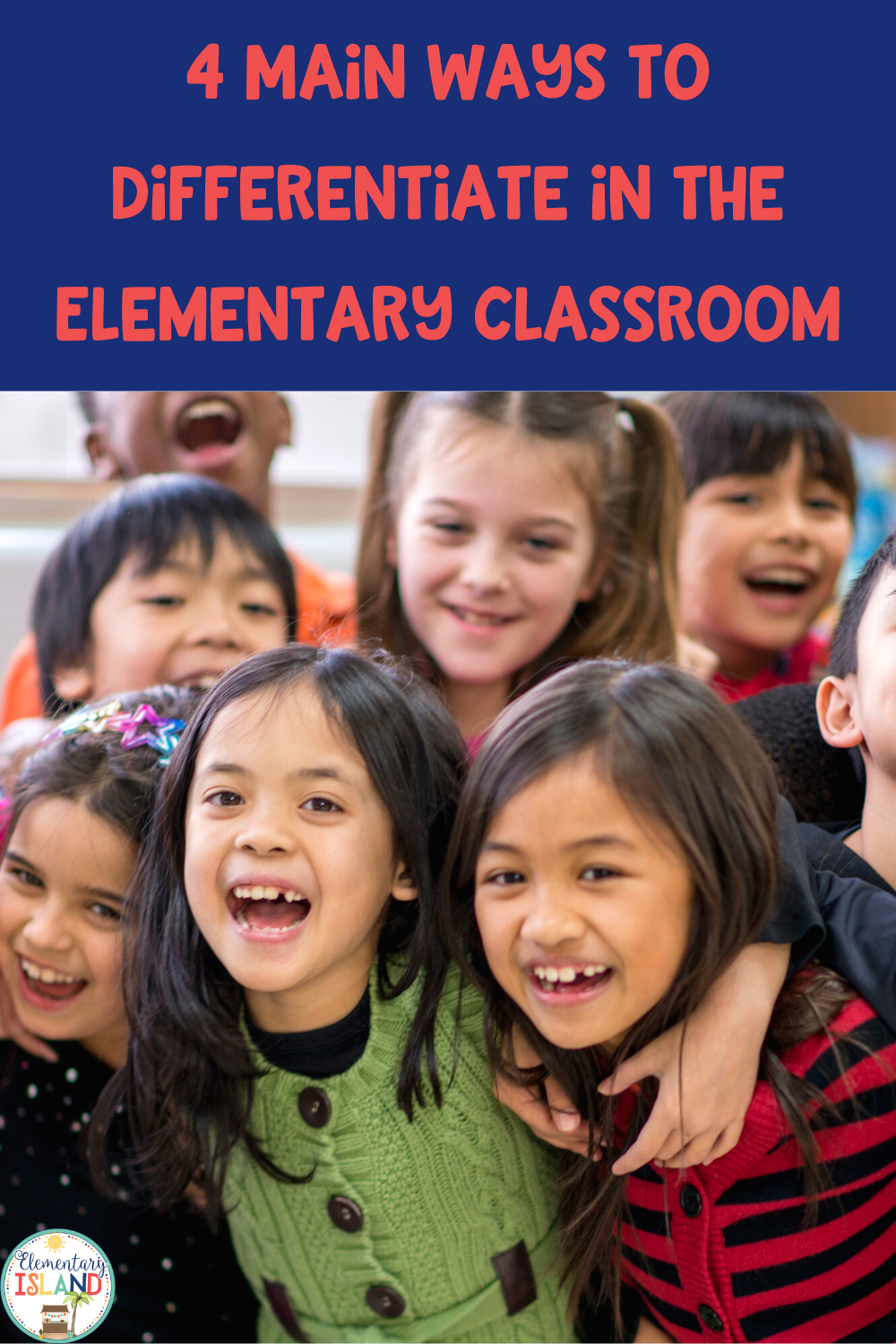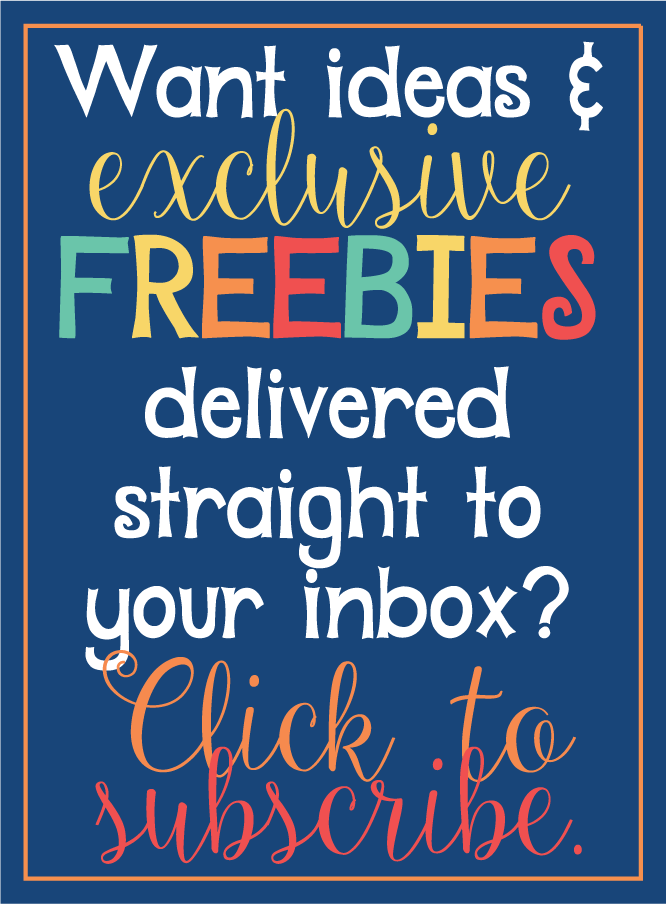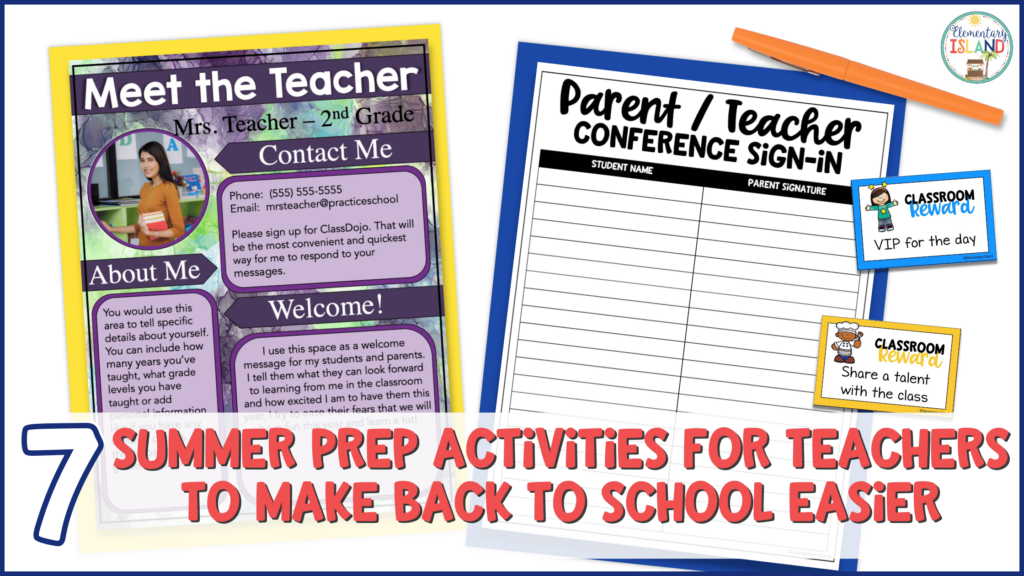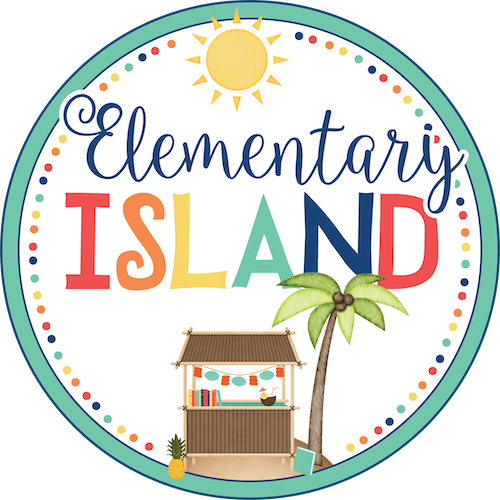In today’s diverse elementary classrooms, teachers face so many challenges. One of the main things that comes to mind is meeting the unique learning needs of every student we encounter. I have found through lots of trial and error that a super effective approach to successfully meeting the learning needs of each of my students is by differentiating my teaching. In this post, I am going to focus on how you can differentiate instruction in the elementary classroom. And. . . I will share the 4 main ways to differentiate effectively in the elementary classroom which include by product, process, content, and through your classroom environment.
What is Differentiation?
Differentiation is all about tailoring instruction to meet the individual needs of each of your students. That means using specific content, processes, products, or learning environments to help meet the needs of the individual students in your classroom.
For helpful ways to get started with the basics of differentiation in your classroom, be sure to check out the previous post in this differentiation series, Practical Steps to Effectively Differentiate in Your Classroom.
Even though differentiation has been around for a while now, it doesn’t mean everyone does it. But, I can tell you from lots of experience that it’s one of the most helpful “tools” I’ve used in my classroom over the years. And, differentiation doesn’t have to be overly complicated or include tons of lesson plans that take hours to write. Differentiation is all about finding out where your students are currently and meeting the m there.
For example, you may have a group of students who you see need a little more help with addition facts. So, to help them, put them in a small group and give them differentiated instruction with a fun center activity, worksheet, Boom Card activity, or anything else that would help give them the extra skills practice they need. At the same time, you may have a group of kiddos who have mastered simple addition and are ready for two or even three-digit addition. You can do exactly the same thing and put them together in a group with worksheets, Boom Cards, etc. for more advanced skills practice to keep them engaged.
See what I mean? It’s all about meeting your kiddos where they are, identifying their needs, and moving on from that point. Easy-peasy!
GRAB THIS FREE DIFFERENTIATION GUIDE TO HELP YOU GET STARTED WITH ALL THINGS DIFFERENTIATION!
1. How to Differentiate Instruction by Product
So, now that we have a basic understanding of what differentiation is, let’s talk about the different ways you can differentiate in your classroom. The first way is by product.
Differentiating by product for elementary students involves offering a range of options for students to demonstrate their understanding of the material. Some practical strategies to implement differentiation by product could include:
Tiered Assignments
Using assignments with different levels of complexity for your students is a great way to effectively differentiate instruction. You are still teaching the same skill to all of your students, but you are able to create tiered assignments for students at different levels of the particular skill mastery. For example, in your math lesson, you can create three sets of problems: basic, intermediate, and advanced. Then, it’s as easy as assigning the tier based on each student’s ability.
Learning Stations
Whether you call these learning stations or centers is up to you. Basically, they are the same with one difference. Learning stations allow you to set up different activities or tasks related to the targeted skill you want your students to practice. As your students rotate through the stations, they will have several different tasks to choose from. Each task helps them practice the same skill, but your students will be able to choose the task that appeals most to them. This means you will have more buy in and your students will stay more engaged and essentially get the most out of their learning experience.
Choice Boards or Menus
You can design a choice board or menu with various assignment options for your students to select from. Include activities that would appeal to the various learning styles and interests of your students. For example, a choice board for a project may include an option to write a story, create a comic strip, make a diorama, or record a video presentation. Not only does this give you the ability to meet your students where they are skill-wise, but it also gives them a sense of independence.
2. How to Differentiate Instruction by Process
Differentiating by process means providing a variety of approaches, resources, and opportunities for your students. By providing a variety of ways for your students to learn, practice, and master key skills and concepts you can be sure each of your students can thrive and achieve their full potential in your classroom. Differentiation by process not only enhances academic achievement but also fosters a love for learning and empowers students to take an active role in their education. How cool is that?
Some easy ways to differentiate by process include:
Individualized Learning Paths
Develop individualized learning paths for students. This means you are creating a specialized learning goal for your students and giving them the opportunity to reach those goals in ways that work best for their learning styles. These paths can be based on pre-assessments or ongoing formative assessments and guide each student’s progress through the curriculum at their own pace.
Cooperative Learning Opportunities
I can’t stress enough how valuable it is to give your students the opportunity to learn from and teach one another. When you are able to incorporate cooperative learning activities in your classroom, your students will feel empowered and excited about learning. For example, for a novel study, it would be helpful to group students with different learning styles together. If you have a student who is fantastic at researching but doesn’t love drawing, putting them together in a group with another student who LOVES any opportunity to be creative means they can work together to find the information they need and creatively show their learning. Not only does collaborative learning enhance understanding of key concepts, but it also fosters an environment of problem solving.
Scaffolded Instruction
Use scaffolding techniques to support your students as they learn new concepts or skills. This is a great “sister” process to the individualized learning paths because you are able to make your scaffolded instruction unique for each student. As your students progress through the skill you are able to gradually reduce support as they become more proficient which allows them to take ownership of their learning. It’s an amazing experience for teachers and students alike!
3. How to Differentiate Instruction by Content
To differentiate by content means you are tailoring your instruction or curriculum to meet the diverse learning needs, abilities, interests, and readiness levels of each of your students. It’s important to remember that each of our students has different prior knowledge, learning styles, and individual strengths.
Ways to effectively differentiate by content could include:
Curriculum Compacting
Curriculum compacting is basically identifying students who have already mastered certain aspects of the content you are teaching and providing them the opportunity to explore them more in-depth. I like to think of these as enrichment activities my students can do that will help them stay engaged in the learning, but also choose something that feels fun for them. Curriculum compacting pairs perfectly with tiered assignments because it gives your students the opportunity to have more voice and choice in their learning.
Use of Technology
We all know how much our students love any opportunity to use technology in the classroom. So, if we can use technology to our advantage when differentiating by content it’s a win-win situation! You can use technology to deliver personalized content or adaptive learning experiences based on the skill level of your individual students. Boom Cards are a perfect resource for differentiating because you can assign decks to students based on the specific skills you want them to be practicing.
Varied Learning Resources
Providing a range of learning materials like textbooks, articles, videos, interactive websites, and hands-on manipulatives helps your students feel more comfortable with how they are learning. When your kiddos are feeling excited about what they are learning because of how the information is presented, you will find them more engaged and actually learning MORE!
You know your students better than anyone and you can probably identify several students who would be more engaged in what they are learning by watching a video. On the flip side, you know there are also several students who wouldn’t have the focus for a video but would excel with an interactive website. Just because your kiddos are learning the content in different ways doesn’t mean one is better than the other. This is where your differentiation is such a success. You are giving every one of your students the opportunity to learn in the way that works best for them!
4. How to Differentiate Instruction by Environment
You may not immediately think of your classroom environment as a tool for differentiation, but it absolutely can be! Differentiation by environment involves adapting the classroom setting, routines, and atmosphere to accommodate the diverse needs of students. By creating a supportive and flexible environment, teachers can optimize learning experiences and ensure that every child feels valued, safe, and motivated to learn. Differentiating by environment recognizes that students respond differently to their surroundings, and it aims to create a space that nurtures their strengths and addresses their challenges.
Some examples of differentiating by environment include:
Classroom Layout
Arranging your classroom to provide multiple learning spaces, such as quiet corners for independent work, collaborative areas for group activities, and designated spaces for hands-on projects is a great way to naturally foster an environment of differentiated learning. You can even create flexible seating options to cater to different learning preferences. These could include standing desks, bean bags, traditional desks, group tables, and more.
Choice and Autonomy
This one might sound a little “out there”, but believe me when I say this can work! At the beginning of the year, quarterly, monthly, or how often you feel is acceptable, offer your students the ability to choose where they sit within the classroom. This might be flexible seating, but it could also be sitting with a specific group.
You can also work together with your class to design the layout of your classroom. This could include a more home-like feel with floor lamps, window coverings, or even a couch. Giving your class (and individual students) the opportunity to have a differentiated learning environment will go a long way in the overall success of your school year.
Calm Corners and Active Areas
Within your class, you are going to have some students who prefer a lot of space to move around when learning. But, you will also probably have several students who do better learning in a snug, cozy and quiet environment. Creating a safe space for both types of learners within your classroom environment can seem impossible, but I promise it’s doable.
Create a designated calm corner workspace for students who need some quiet to focus while working on school work. This can be an area with a special table, comfortable beanbag chairs, etc. But, work together with your class to discuss what this area should look and sound like so the expectations are clear at the beginning of the year. For your active areas, the same concept applies. Working collaboratively with your students, talk about what sort of activities will be appropriate for the active area and what it should look and sound like.
This will help your students take ownership of their learning and give you differentiated areas of your classroom environment for learning to take place in the way that works best for your students.
Differentiation is the Key to Success in Your Classroom
By embracing differentiation by product, process, content, and environment in our classrooms we can create a nurturing and empowering learning environment for our students. This will help each and every one of our students thrive and reach their full potential.
Whether this is your first or 40th year in the classroom, you are sure to find that differentiating instruction is an incredible way to help each of your students feel successful in your classroom.
Differentiation Resources for You
If you are ready to jump into differentiation, I have some amazing resources for you! Check out the Math Differentiation Bundle in the Elementary Island TPT store today! From skip counting and fractions to money and learning about time, I’ve got your differentiated instruction covered!
Don’t Forget this FREE Differentiation Guide
Grab this FREE guide that includes specific instructional strategies for each of the core subjects, a student interest form, and more! It’s the perfect resource to keep in your teacher binder or with your lesson planning supplies so you always have practical tips and ideas right at your fingertips.
Pin it!
Be sure to save these 4 main ways to differentiate instruction in the elementary classroom to your favorite education Pinterest board today!
